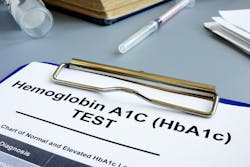Although a hemoglobin A1c (HbA1c) measurement for evaluating patient glycemic control is well established for diagnosis and monitoring in patients with normal hemoglobin, this does not speak to the sizeable minority (~7% worldwide1) of patients with abnormal hemoglobin, for whom the HbA1c test may not be appropriate. These patients possess hemoglobinopathies; genetic mutations affecting the structure (hemoglobin variants), and/or production (thalassemias) of hemoglobin A, resulting in assay interference, altered glycation dynamics, and/or changes to red blood cell (RBC) lifespan that result in a different relationship between the patient’s glycemic status and the measured HbA1c. Some patients with multiple mutations even lack any normal hemoglobin A (Hb A) and, hence, produce no HbA1c.
The 2018 American Diabetes Association update to the Standards of Medical Care in Diabetes first broached this topic with new recommendations, stating that recent evidence “describe[ed] potential limitations in A1c measurements due to hemoglobin variants, assay interference, and conditions associated with red blood cell turnover…”2 This update addresses the laboratory phenomenon of occasional patient samples giving no A1c result, non-physiologic results, or clinically discordant values.
However, these recommendations can be seen to place the laboratory in an unfortunate position: the lab may either routinely perform additional hemoglobinopathy testing on all A1c screening samples or produce results that may be incorrect for a portion of their patients, risking a diabetes misdiagnosis that significantly impacts these patients’ health. Here we will explore the impact of these recommendations, the reasoning behind them, and show how labs can mitigate the risk of invalid testing through careful A1c methodology choice.
The intrinsic nature of Hb A in HbA1c formation makes it unsurprising that structural variants may interfere with detection and measurement of the glycated form, either analytically (in methods unable to distinguish/separate the variant) or clinically (altering the formation or retention of the glycated hemoglobin) as noted in a previous issue of this publication.3 Very often manufacturers, supported by the NGSP,4 indicate no analytical interference from common variants for their methods, but this does not speak to the clinical interference caused by the systemic effects of the variant. In explaining their new recommendations, the ADA noted a study in which Hb S trait (heterozygous Hb S) patients have a systemically lower HbA1c value by 0.3%, 5 even despite the noted higher A1c value found in African American populations6 where the variant is common. A subsequent study found a similar shift in Hb E trait patients.7,8 While these shifts are relatively small, possibly only impacting cases on the borderline of diagnostic cutoff, there are also extreme cases such as sickle cell disease, where the RBC turnover is significantly impacted. Homozygous Hb S9 or Hb S in combination with some other variants (Hb C, D-Los Angeles, O-Arab) results in rapid RBC turnover and cause low glycated hemoglobin fractions. To address this, manufacturer package inserts note that the assay should not be employed “in the absence of Hb A”. Further, some rare hemoglobin variants can cause profound analytical interferences even in trait form.10-14 Proven interferences such as these motivated the ADA to recommend the following:
“Marked discordance between measured A1C and plasma glucose levels should raise the possibility of A1c assay interference due to hemoglobin variants (i.e., hemoglobinopathies) and consideration of using an assay without interference or plasma blood glucose criteria to diagnose diabetes.”
It is further recommended that “In conditions associated with increased red blood cell turnover, such as sickle cell disease… only plasma blood glucose criteria should be used to diagnose diabetes.”15
When identified, a clinician could consider a hemoglobinopathy in conjunction with the A1c result; common trait variants could be disregarded (except in borderline cases, calling for more careful assessment), while severe interferences (compound hemoglobinopathies, or no Hb A) would warrant reflex to an alternate tests or analytes (fructosamine, glycated albumin, fasting blood glucose) as mentioned by the ADA. However, the practical considerations of the laboratory aren’t addressed; how does the lab know which patients have interfering hemoglobinopathies? Interference here is detected after the fact: an A1c result is discordant from the rest of the patient clinical profile, suggesting a variant or altered RBC turnover. While effective in cases of obvious discordance, it presumes access to additional results not always available to the lab, placing the impetus for interference detection on the clinician, a burdensome and roundabout approach to result validation. It further ignores the reality of results less obviously discordant, such as the noted Hb S trait and Hb E trait influencing the A1c value.
This context surrounding HbA1c testing implies a preference for HbA1c techniques capable of incidental hemoglobinopathy discovery. If detected at the time of the A1c testing, then appropriate notice of minor interferences can be provided to the clinician, and extreme discordance (Hb A absence, sickling disease) identified by the lab can be blocked before release. This stratifies the current A1c testing methodologies; those able and those unable to visualize variants and thalassemias.
Testing methodologies incapable of detecting hemoglobinopathies include those employing antisera (immunoassay) or enzymatic digestion. These techniques, using highly specific antisera or enzymes, excel in finding the recognition sequence at the glycated N-terminal beta chains, but their limited scope means they can’t discern further distant mutations, “seeing” only the amino acids within their target region. Variants with mutations outside of this window are included in A1c calculations and may significantly influence the reported value. The boronate affinity method similarly fails to detect variants, as it back-calculates A1c from measurements of all hemoglobins and glycated hemoglobins within the sample, regardless of mutations. The blinded nature of these methods’ results is true even in the extreme cases where no Hb A is present.
Methods capable of detecting hemoglobinopathies (variants and some thalassemias) include HPLC and capillary electrophoresis (CE). A more detailed profile of the patient’s hemoglobins is integral to these methods, as the different fractions are separated by either electrophoretic mobility or affinity to an anion exchange column, isolating the Hb A and HbA1c for measurement. As hemoglobin variants are, by their very nature, structurally different from Hb A or HbA1c, they typically migrate or elute differently on these “separation” techniques, generating distinct and obvious peaks or distortions. This indicates patients who have hemoglobinopathies for closer analysis, while normal patients will pass without note. All the common variants (and many rare variants) are distinctly visualized, and using a separation methodology significantly minimizes the chance of an undetected variant interfering with A1c measurement.
This presents a seemingly obvious choice: the laboratory can employ either a “separation” technique, or a technique where hemoglobinopathies are undetected, leaving them uncertain of their result without additional testing. However, practical considerations of lab testing may not allow for the obvious choice. Many labs resort to the expediency of running non-separation, low-resolution techniques and simply “send out” samples with questionable results, hoping reference labs will solve the problem for them. Unfortunately, reference lab may not be employing the separation techniques either. Labs may assume that separation techniques have lower throughput, and result review may seem an intensive, specialized job, especially as staffing shortfalls are common in the modern laboratory. There simply are not technologists available to review every A1c result in even the moderate-volume laboratories. Fortunately, workflow improvements solve these challenges; for example, the capillary systems employ an auto-flagging software that detects and flags abnormal profiles. Normal profiles require no further review, with their results sent automatically to the LIS. The remaining samples, representing the significant but small minority of patients with hemoglobinopathies, can be retained for review, representing a more reasonable workload. Those samples exhibiting non-analytically interfering variants are reportable, and appropriate notice to the clinician could be provided. The remaining few, where A1c results are inappropriate for diabetes diagnosis, could be referred for alternate analyte testing.
Further streamlining could rely on the genetic nature of hemoglobinopathies; a hemoglobin variant or thalassemia will not “suddenly develop” in a patient. Separation techniques could therefore be used for an initial screen and those patients exhibiting no indication of hemoglobinopathies would be transferred for future monitoring on “non-separation” techniques without concern for an unknown interference and undetected misreporting of results. Those patients with incidental hemoglobinopathies detected would have their clinicians notified and be flagged for future monitoring by a separation technique or by an alternate analyte, as appropriate. This approach could be viewed as a modification of approaches suggested elsewhere16,17 especially for screening populations with high hemoglobinopathy incidence.
Despite decades of use for the diagnosis and monitoring of diabetes, laboratory standards have only recently addressed how HbA1c testing should account for the presence of hemoglobinopathies that could potentially interfere, both analytically and clinically, with the result. The use of a separation technique for HbA1c measurement allows for the detection of hemoglobin variants and thalassemia without the associated cost of additional testing. Recent advances in result review and workflow have mitigated the throughput, complexity, and labor intensity surrounding the use of these higher-resolution techniques and will enable labs to release timely A1c results with confidence.
References
1. Kohne E. Hemoglobinopathies: clinical manifestations, diagnosis, and treatment. Dtsch Arztebl Int. 2011;108(31-32):532-540. doi:10.3238/arztebl.2011.0532.
2. Summary of Revisions: Standards of Medical Care in Diabetes-2018. Diabetes Care. 2018;41(Suppl 1):S4-S6. doi:10.2337/dc18-Srev01.
3. Flamini, M. A holistic overview of hemoglobinopathies interactions with glycated hemoglobin. Medical Laboratory Observer. Published August 24, 2022. Accessed July 19, 2023. https://www.mlo-online.com/disease/diabetes/article/21276454/a-holistic-overview-of-hemoglobinopathies-interactions-with-glycated-hemoglobin.
4. HbA1c Assay Interferences. Ngsp.org. Accessed July 19, 2023. https://ngsp.org/interf.asp.
5. Lacy ME, Wellenius GA, Sumner AE, et al. Association of sickle cell trait with hemoglobin A1c in African Americans. JAMA. 2017;317(5):507-515. doi:10.1001/jama.2016.21035.
6. Herman WH, Ma Y, Uwaifo G, et al. Diabetes Prevention Program Research Group. Differences in A1c by race and ethnicity among patients with impaired glucose tolerance in the Diabetes Prevention Program. Diabetes Care. 2007;30(10):2453-7. doi:10.2337/dc06-2003.
7. Pratumvinit B, Reesukumal K, Hanyongyuth S, et.al. Hemoglobin A1c Levels Are Slightly but Significantly Lower in Normoglycemic Subjects with the Hemoglobin E Phenotype. Ann Lab Med. 2019;39(2):209-213. doi:10.3343/alm.2019.39.2.209.
8. Paisooksantivatana K, Kongsomgan A, Banyatsuppasin W, Khupulsup K. Influence of hemoglboin E on measurement of hemoglobin A1c by immunoassays. Diabetes Res Clin Pract. 2009;83(3):e84-5. doi:10.1016/j.diabres.2008.11.021.
9. Solanki DL, McCurdy PR, Cuttitta FF, Schechter GP. Hemolysis in sickle cell disease as measured by endogenous carbon monoxide production. A preliminary report. Am J Clin Pathol. 1988;89(2):221-5. doi:10.1093/ajcp/89.2.221.
10. Rodriguez-Capote K, Estey MP, Barakauskas VE, et.al. Identification of Hb Wayne and its effects on HbA1c measurement by 5 methods. Clin Biochem. 2015;48(16-17):1144-50. doi:10.1016/j.clinbiochem.2015.07.100.
11. Kangastupa P, Akerman K, Risku S, et.al. The prevalence of hemoglobin Tacoma in Finland detected by HbA1c capillary electrophoresis. Scand J Clin Lab Invest. 2023;83(1):51-57. doi:10.1080/00365513.2022.2164739.
12. Li Y, Tang J, Zheng L, Tang K, Li L. False hemoglobin A1c value as a result of compound heterozygotes of hemoglobin E and hemoglobin New York. J Diabetes Investig. 2023;14(3):494-497. doi:10.1111/jdi.13971.
13. McKeague S, Peake N, Lovelock D, Chow J, Benson R, Fanning S. Acquired HbH disease diagnosed by Hb A1c capillary electrophoresis. Br J Haematol. 2023;200(6):687. doi:10.1111/bjh.18587.
14. Karimi SS, Jin M, Murga-Zamalloa C. Analytical and clinical significance of rare hemoglobin variants during HbA1c monitoring in patients with diabetes mellitus: Two cases of hemoglobin G-Ferrara and hemoglobin G-Copenhagen in diabetic patients with sickle cell trait. J Appl Lab Med. 2023;6;8(2):407-412. doi:10.1093/jalm/jfac135.
15. American Diabetes Association. 2. Classification and Diagnosis of Diabetes: Standards of Medical Care in Diabetes-2018. Diabetes Care. 2018;41(Suppl 1):S13-S27. doi:10.2337/dc18-S002.
16. Gordon DK, Hussain M, Kumar P, Khan S, Khan S. The sickle effect: The silent titan affecting glycated hemoglobin reliability. Cureus. 2020;12;12(8):e9685. doi:10.7759/cureus.9685.
17. Today C. ‘Hundreds of variants’—Staying alert to HbA1c method interference. CAP TODAY - Pathology/Laboratory Medicine/Laboratory Management. Published May 17, 2023. Accessed July 19, 2023. https://www.captodayonline.com/hundreds-of-variants-staying-alert-to-hba1c-method-interference/.





